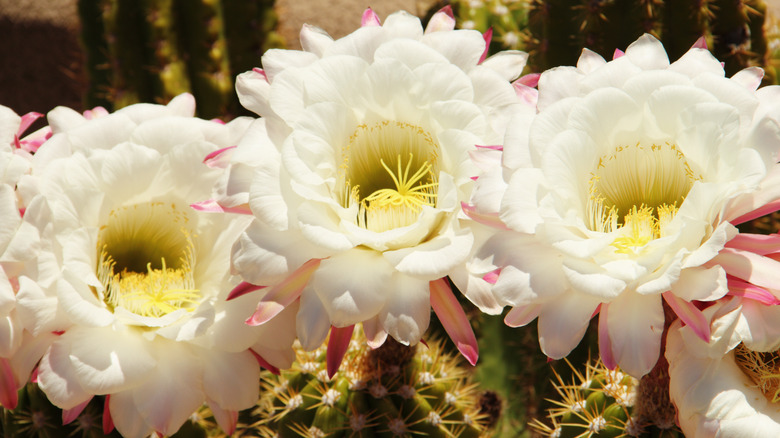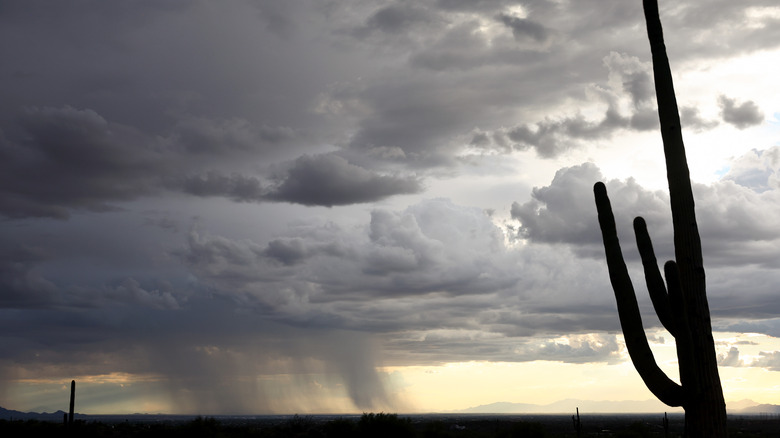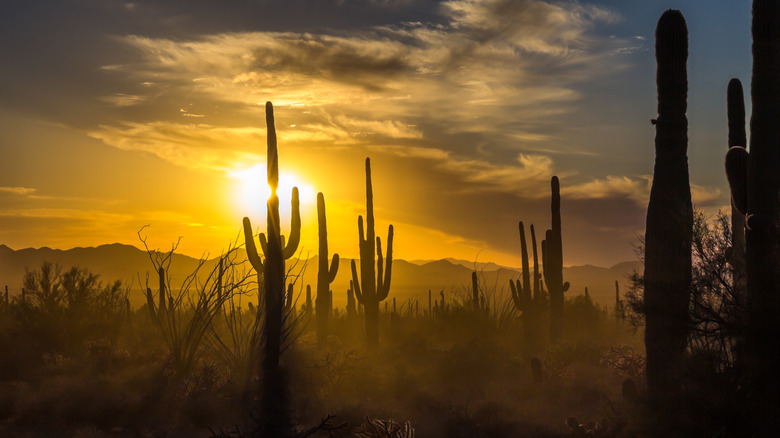How The Saguaro Blossom Became Arizona's State Flower
The first piece of iconography most people think of in association with nations and states is their flag. For some countries, the national animal is similarly recognized. But national flowers tend not to be as well-known, at least in certain parts of the world. The United States has only had a national flower since 1986 — the rose, and it doesn't get nearly the same amount of use as the stars and stripes or the bald eagle. But floral emblems have long been a part of nationhood, by no means confined to the Anglosphere or even Europe. They've been used to represent the native landscapes and flora of a given country, while other national flowers are chosen for symbolic meanings associated with the national character or narrative.
Regions, provinces, and states have their own iconography, floral badges included. The Tudor rose, thistle, and shamrock of their respective regions of the United Kingdom rival the Union Jack and the lion and unicorn as ubiquitous symbols. And according to USA Today, all 50 U.S. states have state flowers. For Arizona, that flower is the saguaro cactus blossom, though the treelike cactus itself might cut more of an iconic silhouette. While officially chosen as a floral emblem in 1931 by the state general assembly, the saguaro was used to represent Arizona long before that.
The saguaro cactus was part of the Arizona territory's image
There are varying stories about the origins of the saguaro cactus and blossom in Arizona's history. In 1963, Richard Cunningham McCormick was appointed the Arizona territory's first secretary; he later became its second governor and a major force in the territory's early history according to the Sharlot Hall Museum. Unfortunately, Cunningham seems to have made a better statesman than a graphic designer — his constituents rejected multiple drafts of his design for a territorial seal, per "Official State Flowers and Trees: Their Unique Stories." The earliest seal recorded with the office of the Arizona Secretary of State, attributed to McCormick, doesn't feature a saguaro or any cactus, but mountain scenery. Eventually, McCormick was allegedly given specific guidelines — including a "columnar cactus."
Whether it was meant to be there from the start or not, a saguaro cactus was eventually incorporated into later seal designs, and the saguaro flower didn't lose its appeal as a possible symbol. By 1901, it was considered the floral representative of Arizona territory. And in 1931, 19 years after Arizona became a state, an act of the general assembly officially made the saguaro the state flower on March 16.
The cacti are long-lived and durable
The saguaro is a fitting choice for Arizona's state flower, being a native plant of the state, but Arizona isn't the only place you can find it. The saguaro grows throughout the Sonoran desert, which covers not just southwestern Arizona but parts of California and Mexico. It even shares a name with the Mexican state of Sonora. Saguaro cacti can also be found along the Colorado River.
The saguaro is the largest cactus to grow in the United States, hence its adoption as a broader symbol of the American West as well as Arizona. It's estimated that saguaros can live for over 200 years, and it can take them up to 75 years to reach maturity. When fully grown, a cactus can stand over 50 feet tall. The blossoms that Arizona has adopted as its state flower bloom between April and June, and then only at night. Appropriately enough, one of the major pollinators for saguaros are bats, at least on the night shift; bees and birds do so during the day.
Saguaros produce sweet fruit and retain plenty of water, and indigenous people relied on them as a source of food and water. While the saguaro isn't endangered, it does have legal protection from defacement, and it's lent its name to Saguaro National Park in Pima County.


